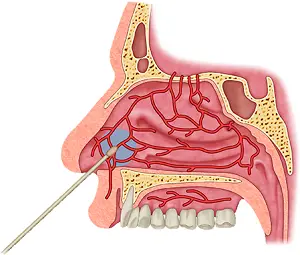How Much Does Nose Cauterization Cost?
Last Updated on August 21, 2023
Written by CPA Alec Pow | Content Reviewed by ![]() CFA Alexander Popinker
CFA Alexander Popinker
Bleeding from the nose is common in children and usually, this shouldn’t warrant any medical attention. But nosebleeding can also be caused by infection, an allergy, fragile blood vessels, nose picking, frequent sneezing, or an object being pushed into the nostril.
Nose cauterization is one of the most common medical procedures, also considered one of the easiest you could get. This quick procedure can help prevent nosebleeding if it becomes a frequent problem. It can also help close open wounds and fight some types of infections.
During the procedure, the inside of your nose will be numbed and the doctor will use a chemical swab or an electric current to cauterize and seal the blood vessels. This procedure stops the bleeding by building scar tissue around your blood vessels which prevents future nosebleeds.
How much does nose cauterization cost?
Nose cauterization costs anywhere between $80 and $520, depending on factors like the type of procedure being done, the doctor you choose to work with, your location, and so on. For example, a chemical nose cauterization is usually between $86 and $175, while for an electrical cauterization process, you will probably spend between $290 and $520.
These costs cover the fee for the visit to the doctor as well as the procedure itself without any health insurance coverage. Of course, the cost can increase if the doctor needs to take blood work to make sure that the nose bleeding isn’t caused by a serious underlying medical condition.
Usually, your health insurance can cover the procedure if this issue is deemed medically necessary. Keep in mind that you are responsible for your deductibles and co-pays. However, you should ask your doctor’s office and health insurance company for more information about your payment responsibilities.
According to an answer provided on JustAnswer.com by a doctor, the cost of nose cauterization will vary regionally, but regardless of your location, if you need a chemical swab, the price would be somewhere around $60 to $115 while for an electrical cautery, you will probably end up spending a few hundred dollars.
Nose cauterization procedure
 When it comes to the procedure itself, the first and most important step is to determine the cause of the bleeding. During your initial consultation, before the cauterization can start, your doctor will have to examine your nostrils. Also, a sample of blood may be needed to see if there are other significant issues to consider, like anemia.
When it comes to the procedure itself, the first and most important step is to determine the cause of the bleeding. During your initial consultation, before the cauterization can start, your doctor will have to examine your nostrils. Also, a sample of blood may be needed to see if there are other significant issues to consider, like anemia.
The procedure is quick and painless. Before the surgery, your nose will be numbed with a local anesthetic. This will take place in a private hospital, a private clinic, a surgery center, or even in the doctor’s office. As stated above, one of the two medical procedures will be considered.
The first one is the electrical cautery, in which your doctor inserts a heated needle with electricity into your nostrils to seal the blood tissues. The second type of procedure is called a chemical swab. For the second procedure, a caustic agent is used, which will use chemical reactions to help seal the blood tissues.
You might also like our articles on the cost of septoplasty, blood tests, or biopsies.
You will find that not all doctors perform both methods. This is something that will vary from one doctor to another. You might need to get in touch with different doctors to find one that performs the method that you consider is best for you and your particular situation.
According to some talks online, most people state that their experience when it comes to this procedure is very quick and painless. Dan Dickinson, for example, explained the procedure step by step in one of his blog posts. According to him, a Q-tip-like device is inserted in the affected nostril, having a chemical substance on its end. The affected area is then rubbed with the device so that the substance can be applied, to strengthen the tissue.
When the Q-tip touches the inside o the nostril, you might experience a burning-like sensation, but according to him, this is nothing to be afraid of, as the entire process was quite painless.
Keep in mind that he chose the chemical swab, so the process might be different from the electrical cauterization. The surgery is performed in an outpatient setting and you will be sent home right after it has been performed successfully.
Your recovery from nasal cautery
At the begging of the recovery process, your affected area may feel itchy, and/or you might experience slight pain in your nose or sinuses. However, you can ease those symptoms with some over-the-counter medication. Other types of post-procedure discomfort and side effects may appear as the need to touch or pick the inside of your nose, or an itching sensation.
For successful healing, you will have to be extra careful with the way you touch your nose for the next two weeks at least. No touching of your nose is allowed, especially the inside of your nostrils, no nose bumping, and no nose-blowing. However, if your nose does bleed, pinch it shut for 10 minutes to stop the bleeding.
Due to the fact that the area needs to be kept moist, applying an antibacterial ointment or a saline nasal spray inside of your nose, is needed. This will be required for the next 10 days after the intervention.


Leave a Reply
Want to join the discussion?Feel free to contribute!